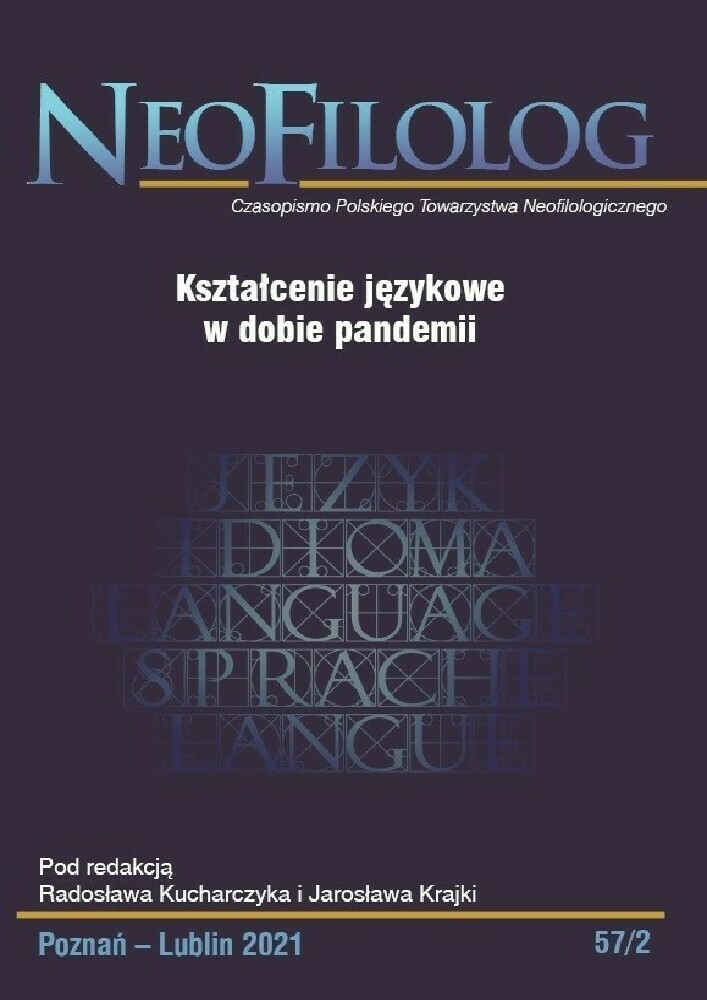Abstrakt
Modern technology has already changed the way we live, but the COVID-19 pandemic has provided us educators with an unprecedented situation in which we are faced with the enormous challenge of teaching online for a long period of time. It is therefore important to analyse various techniques for getting the most out of distance teaching, especially in a synchronous mode. The aim of the study discussed in this article was to analyse students’ attitudes towards collaborative online work undertaken in synchronous mode during the pandemic. Thirty-three first-year BA students studying English Philology participated in this study. Respondents reflected on the process of online, synchronous collaboration via MS Teams by answering an online survey. The results of the study revealed that collaborative learning allows participants to actively participate in an online lesson, interact with others, co-construct a writing task, apply the new language introduced in lessons in a practical task and receive almost instant feedback. Consequently, any sense of isolation the students may feel is reduced and a sense of community is developed. In addition to this, a collaborative task enhances students’ use of academic skills and the development of key competences that can lay the foundation for lifelong learning.
Bibliografia
Arnó-Macià E. (2014), Information Technology and Languages for Specific Purposes in the EHEA: Options and Challenges for the Knowledge Society, (in:) Bárcena E., Read T., Arús J. (eds.), Languages for Specific Purposes in the Digital Era, Educational Linguistics series, 19, Springer, Cham, pp. 3–25.
Bernard R.M., Rojo de Rubalcava B. (2000), Collaborative online distance learning: Issues for future practice and research. “Distance Education”, 21 (2), pp. 260–277.
Blin F., Appel C. (2013), Computer Supported Collaborative Writing in Practice: An Activity Theoretical Study. “CALICO Journal”, 28 (2), pp. 473–497.
Brandon D.P., Hollingshead, A.B. (1999), Collaborative learning and computer-supported groups. “Communication Education”, 48 (2), pp. 109–126.
Dembo M.H., Seli H. (2016), Motivation and Learning Strategies for College Success. A Focus on Self-Regulated Learning, 5th ed., Routledge.
Długosz P., Foryś G. (2020), Zdalne nauczanie na Uniwersytecie Pedagogicznym im. Komisji Edukacji Narodowej w Krakowie z perspektywy studentów i wykładowców. Kraków: Wydawnictwo Naukowe Uniwersytetu Pedagogicznego.
Elola I., & Oskoz A. (2010), Collaborative writing: fostering foreign language and writing conventions development. “Language Learning & Technology”, 14 (3), pp. 51–71.
European Commission (2018), Council Recommendation on key competences for lifelong learning. (2018/C 189/01). Retrieved from: https://eur-lex.europa.eu/legal-content/EN/TXT/PDF/uri=CONSIL:ST_9009_2018_INIT&from=EN [Date of access 01.03.2021]
Friedman D.A. (2012), How to Collect and Analyze Qualitative Data, (in:) Mackey A., Gass S.M. (eds.), Research Methods in Second Language Acquisition. A Practical Guide, Wiley-Blackwell, pp. 180–200.
Humphreys G., Wyatt M. (2014), Helping Vietnamese university learners to become more autonomous. “ELT Journal”, 68 (1), pp. 52–63.
Janssen J., Erkens G., Kirschner P.A., et al. (2012), Task-related and social regulation during online collaborative learning. “Metacognition and Learning”, 7, pp. 25–43.
Järvelä S., Rosé C.P. (2020), Advocating for group interaction in the age of COVID-19. “International Journal of Computer-Supported Collaborative Learning”, 15, pp. 143–147.
Kálmán C., Eugenio E.G. (2015), Successful language learning in a corporate setting: The role of attribution theory and its relation to intrinsic and extrinsic motivation. “Studies in Second Language Learning and Teaching”, 5 (4), pp. 583–608.
Komorowska H., Krajka J. (2020), The Culture of Language Education. Foreign Language Teaching in Diverse Instructional Contexts. Peter Lang.
Krajka J. (2012), The Language Teacher in the Digital Age – Towards a Systematic Approach to Digital Teacher Development. Lublin: Wydawnictwo Uniwersytetu Marii Curie-Skłodowskiej.
Li M. (2018), Computer-mediated collaborative writing in L2 contexts: an analysis of empirical research. “Computer Assisted Language Learning”, 31 (8), pp. 882–904.
Lowry P.B., Nunamaker J.F. (2003), Using Internet-Based, Distributed Collaborative Writing Tools to Improve Coordination and Group Awareness in Writing Teams. “IEEE Transactions on Professional Communication (IEEETPC)”, 46 (4), pp. 277–297.
Mason R., Rennie F. (2008), E-Learning and Social Networking Handbook: Resources for Higher Education. New York and London: Routledge.
Nykopp M., Marttunen M., Erkens G. (2019), Coordinating collaborative writing in an online environment. “Journal of Computing in Higher Education”, 31, pp. 536–556.
Palloff R.M., Pratt K. (2005), Collaborative Online. Learning Together in Community. San Francisco, CA: Jossey-Bass.
Palloff R.M., Pratt K. (2013), Lessons from the Virtual Classroom: The Realities of Online Teaching. 2nd ed. San Francisco, CA: Jossey-Bass.
Siemens G., Tittenberger P. (2009), Handbook of Emerging Technologies for Learning. Retrieved from: http://elearnspace.org/Articles/HETL.pdf [Date of access: 4.08.2015]
Sin C., Veiga A., Amaral A. (2016), European Policy Implementation and Higher Education. Analysing the Bologna Process. London: Palgrave Macmillan.
Storch N. (2005), Collaborative writing: Product, process, and students’ reflections. “Journal of Second Language Writing”, 14 (3), pp. 153–173.
Storch N., Wigglesworth G. (2007), Writing tasks: Comparing individual and collaborative writing, (in:) García Mayo M.P. (ed.) Investigating tasks in formal language learning, London: Multilingual Matters, pp. 157–177.
Storch N. (2013), Collaborative Writing in L2 Classrooms. Bristol, UK: Multilingual Matters.
Strobl C. (2014), Affordances of Web 2.0 Technologies for Collaborative Advanced Writing in a Foreign Language. “CALICO Journal”, 31 (1), pp. 1–18.
Topol P. (2020), Metody i narzędzia kształcenia zdalnego w polskich uczelniach w czasie pandemii COVID-19 - Cz. 2, Dyskusja 2020. Studia Edukacyjne, 59, pp. 103–117.
Uribe D., Klein J.D., Sullivan H. (2003), The effect of computer-mediated collaborative learning on solving iII-defined problems. “Educational Technology Research and Development”, 51, pp. 5–19.
Wilson J. M., Straus S.G., McEvily B. (2006), All in due time: the development of trust in computer-mediated and face-to-face teams. “Organizational Behaviour and Human Decision Processes”, 99, pp. 16–33.
Licencja
Prawa autorskie (c) 2021 Yuliya Asotska-Wierzba

Utwór dostępny jest na licencji Creative Commons Uznanie autorstwa – Bez utworów zależnych 4.0 Międzynarodowe.
Przedstawiany utwór (artykuł) upubliczniany jest na podstawie umowy z autorem i na licencji Creative Commons Attribution-NoDerivatives 4.0 International (CC BY-ND 4.0).
Użytkownicy mają obowiązek podania wraz z rozpowszechnionym utworem, informacji o autorstwie, tytule, źródle (odnośniki do oryginalnego utworu, DOI) oraz samej licencji;
- bez tworzenia utworów zależnych,
- utwór musi być zachowany w oryginalnej postaci.
Uniwersytet im. Adama Mickiewicza w Poznaniu zachowuje prawo do czasopisma jako całości (układ, forma graficzna, tytuł, projekt okładki, logo itp.).

